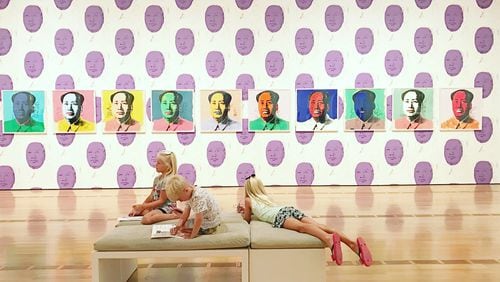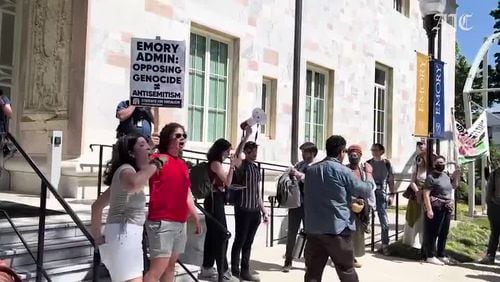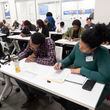In a guest column today, two authors urge more opportunities for children and their families in Atlanta to see, touch and experience art.
Brandon Hinman of Atlanta is the executive director of AIR Serenbe in Chattahoochee Hills. He serves on the board of Capita, a national ideas lab based in Greenville, S.C., that works to ensure a future in which all children and families flourish. Co-author Joe Waters is Capita's CEO.
By Brandon Hinman and Joe Waters
Experts from across the nation and world recently came to Atlanta to describe their visions for how our city could become an international model for creating better places for children and their families to thrive.
At the second annual Childhood By Design, we discussed how creative thinking and the arts are critical parts of our social infrastructure that create conditions through building social capital and networks to lift up all. Last year's event focused on reimagining early childhood in America, and drew many researchers, artists, educators, advocates, and designers to Serenbe, an arts- and nature-focused community southwest of Atlanta.
Most recently, we brought leaders together to learn how the arts and design can be part of a broader, emerging vision for lifting up all Atlantans, and even helping improve education and reduce poverty.
The arts and creativity are premiums for Atlanta that improve residents’ quality of life -- and even add long-term viability in our workforce. Businesses and nonprofits value creative people who bring energy and solutions to any organization or community.
Many of today’s parents didn’t grow up as active participants in the arts. People in Atlanta, its surrounding area, and beyond need more opportunities for children and their parents, grandparents, teachers, caregivers, and others to experience something important together.
Children’s development depends on more than classroom teaching or academic standards. Those things are important but are more powerful when coupled with a supportive and healthy city, where people of all walks can interact and be more creative.
For instance, the High Museum of Art now offers a free monthly "smart box" for every child, with free arts materials and materials to help them find a piece of artwork and questions that caregivers can ask a child. Families can come back monthly for another box to enjoy. This is a recurring way for children and their caregivers to have a shared experience at the museum and after they leave.
At the Childhood By Design event, a project of AIR Serenbe. the artist-in-residence program at Serenbe, and the nonprofit organization Capita, Kimberly Lucas of the Boston mayor’s office spoke of her city’s work to design more creative places for childcare workers and caregivers who often “live and work in the same spaces.” She described the importance of “third spaces” in cities, where people are not at home or work but can be quiet and alone, or find company.
Israeli architect Itai Palti spoke on how this work needs to be a priority for our city, region, nation and world. Palti founded the "Conscious Cities movement" to embed brain science into the design of buildings, parks and other public spaces. His ideas are spreading globally.
Providing more people with a “kind of agency, seeing yourself imprinting onto the world, is very powerful,” Palti said, supporting social capital and cohesion.
This is an approach we want Atlanta and other cities to take to heart, thinking of how to provide more spaces for play and creativity to help families deal with toxic stress. A stressful environment shrinks your capacity for empathy. We all need time to think for ourselves and consider what others are experiencing. Heavy traffic and long commutes, for example, can actually diminish the quality of our lives. Children reflect the stress they see in their parents and other caregivers.
Which means maybe we should focus on traffic snarls as much improving early childhood programs. Both are important.
At Childhood By Design, Woodruff Arts Center CEO Doug Shipman described how the center is changing its entire approach to programming and outreach to provide a way "in" for every person in the community. Each summer, the Woodruff Arts Center offers an exhibition for young audiences and an accompanying performance at the prestigious Alliance Theatre. This year it was "Winnie the Pooh."
Artwork from the Pooh books and cartoons were presented at the High Museum at children’s eye level. The Atlanta Symphony also now offers a “petting zoo,” during which children and families can explore music, handle instruments, and interact with artists, Shipman told us.
The exceptional Theatre for the Very Young, offering high-quality performances specifically for children at the Woodruff Arts Center. The plays literally engage children in the shows at times, and their caregivers, too. They’re fun, meaningful, and help kids develop creativity from a very early age.
The High Museum is now featuring Japanese artist Yayoi Kusama's dazzling Infinity Mirrors, works of glass and lights that seem to challenge reality. Part of the exhibit allows visitors to walk into a room where everything is painted white and can place colorful polka-dot stickers on the walls, floor, a sofa, tables, lamps, or anywhere.
The result is brilliant. One visitor recently exclaimed, “We’re making art!”
This is the kind of experience we envision for all Atlantans, especially children and their families, to enjoy throughout the city, and everywhere.
About the Author







